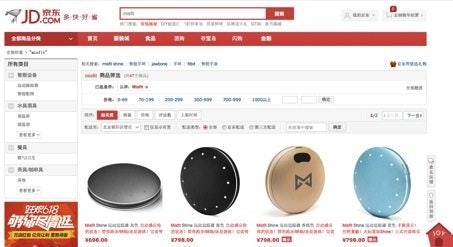
Looks from the 360Fashion & Tech Runway Show 2014 at GSMA in Shanghai. (360Fashion)
As a pioneer and advocate of the solutions mobile can offer to fashion labels, 360Fashion Network CEO and Founder Anina Net has never stopped investigating and educating brands, officials, and consumers about the growing opportunities of the quickly evolving wearable technology market in China. Net recently brought the latest trends in wearables to the forefront at two recent China tech events: the GMIC conference in Beijing in which she participated and the GSMA Mobile Asia Expo, where she organized the very first 360Fashion & Tech Runway Show that took place on June 13. Featuring the latest trends in the integration of the fashion and technology industries, the runway event showcased presentations by global and Chinese designers using techniques such as 3D scanning and 3D printing, in addition to the rapidly developing wearables market.
In order to gain more insights about the potential for wearable technology in China, I talked to both Net and Sonny Vu, the CEO of Misfit Wearables, who introduced the company's Shine activity tracker at GMIC. The tracker was also featured in several 360Fashion looks at the June 13 runway show with the aim of showcasing how high-tech can be merged with high-fashion.
When and where did you first start to work on both fashion and mobile, as well as connected objects?#
Anina Net (AN):#
Actually, I started 360Fashion Network together with Nokia Corporation and Sixapart’s Loic Lemeur as a 360-degree overview of the fashion industry with live blogging. I brought the first mobile blogs to the fashion industry and at that time no one even knew what a blog was, let alone how to do it from the mobile phone. After that, I did projects applying emerging technologies to the fashion industry (live streaming from mobile phones with Vodafone, geo-locating stores on maps with France Telecom, creating mobile fashion dress-up game with Adobe, and a DIY fashion app platform called MobileMags to support emerging designers).
In China, I caught the attention of the CNGA (China National Garment Association) who produce the largest fashion expo in Asia. They offered me [the opportunity] to co-organize with them the CHIC 360Fashion & Tech Zone at their exhibition to showcase the latest technologies and explain to the brands how to use them in their retail, business, and marketing campaigns.

The Misfit Shine wireless activity tracker takes the stage in a look at the 360Fashion & Tech Runway Show at GSMA in Shanghai. (360Fashion)
We have produced this event together for the last three years. Beijing Design Week then invited 360Fashion Network to create a 3D Festival and expand our reach to the design, architecture, and related fields. In 2012, GSMA invited 360Fashion Network down to Shanghai for an exhibition on fashion and tech again, offering a view for technology companies on how to create solutions for the fashion industry. We have built mobile apps for brands like Vero Moda, and helped them with their O2O marketing by integrating activity seamlessly from online to offline.
Sonny Vu (SV)#
: We've been thinking about wearables and other "Internet of Things" products for a number of years now and think that with the ubiquity of mobile internet has really made these product much more viable and useful for the consumer market.
Wearables were also on the GMIC agenda in early May in Beijing: what’s really going on in the Chinese market? What are the key challenges as well as the main opportunities in China versus the West?#
AN:#
I see the next generation of young designers fully focused on technology. The last China Graduate Fashion Week was a testament to the digital natives who didn’t know a time when there wasn’t a cellphone, chat, or apps. Their clothing reflects our times and shows that they are yearning to live in an interactive world where they can consume information in a visual, electronic, and experiential way. "Augmented Reality" will become commonplace and the physical manifestations of pointing your phone at something and receiving information [will become] a common user experience. The problem is that the decision-makers at the top need to die to the old way of doing things in order for this party to get started.

A look designed by Fatima from Raffles College of Design and Commerce (Sydney) at the China Graduate Fashion Week 2014. (360Fashion)
I believe that we don’t see wide adoption of technology because the fashion industry, the very fabric stitched into our everyday lives, has not adopted modern digital communication tools throughout their business. Once the fashion industry makes digital lifestyle fashionable, we will really see the world around us in a new way. The tech industry often underestimates how important fashion is, but it's everywhere, from clothing to toothbrushes, to couches, to curtains, to wine bottles, to our bags. Fashion touches everything and it is the wearable bridge that will build it in and make it accepted.
SV#
: I would say the top two challenges for both the Chinese and Western markets are: first, getting product execution to a level where users can have truly seamless experience and where technology is providing for really compelling use cases and aren't just high-tech toys; second, getting the level of consumer awareness of these new product categories to a level where the early majority is readily adopting them rather than just the early adopters and experimentalists, otherwise, the markets are simply not large enough to support an interesting ecosystem.
Can you tell us respectively about the
360Fashion & Tech Runway Show 2014
you organized at GSMA in Shanghai last week
, and the Misfits products you introduced at GMIC?
AN:#
We’ve produced the largest fashion and technology show—the first in China. Sports trackers, brain visualization headbands, smart watches, body scanning, and 3D Printing from AURACLE SOUND, Misfit Shine, INTERAXON Muse, Samsung Gear 2, Netamo June, Parrot AR DRONE, idea Printer, Ai.Frame Robotics, KORTIDE, BEST SHOW, Welomo, AndyInc, Zhitu, and EventDove (more than 10 tech enterprises in China and overseas) suggested the young generation’s desire to integrate technology into their fashion apparel, and the latest trends of the technology industry that will aid this integration.
The fashion show was a visual conversation about today’s leading technology trends and the fashion designers of tomorrow. Among them [were] Polish, German (from MOON Berlin), Australian, and Finnish designers, and young designers who graduated from Chinese universities including the Minzu University of China, Beijing Union University, Hubei Institute of Fine Arts, Fashion School of Zhejiang Sci-Tech University, and more, as well as Raffles Design and Art College (Australia), all provided over 50 pieces of themed design works.
Juniper Research forecasts that nearly 70 million intelligent wearable devices will be sold in 2017. According to the market response, many wearable devices need to be designed with more fashion elements to become popular products.

A model shows off a Samsung Gear2 smart watch at the 360Fashion & Tech Runway Show in Shanghai. (360Fashion)
SV:#
At GMIC, we introduced our first product, a wearable device called Shine, which is an elegant fitness and sleep monitor that you can wear anywhere. It's a small metal disk that lights up when you double tap it and tells you how active you've been (steps, calories, distance walked) as well as how long and how well you slept. It has a number of available accessories so you can wear it in a number of different locations on your body and for various occasions, not just for exercise.
We were very excited to be at the Fashion and Tech Show in Shanghai, where we started to show off some of the most beautiful ways Shine can be worn with the new accessories that we have. Unlike other wrist-worn activity monitors on the market, Shine can be worn in numerous different ways and can fit into a variety of fashion tastes. We’ve shown off a number of different clothing and jewelry accessories that were designed to host Shine.
Our first customers are in China, where we sell through several e-commerce platforms such as JD.com since October 2013, Tmall, Taobao, Funtalk, Apple Premium resellers, and Amazon.

The Misfit Shine on JD.com. (JD.com)
Why should brands embrace fashion and mobile technology/wearables in China? Can you name a few which you think are pioneers and/or may lead the path?#
AN:#
Because China is the manufacturing capital in the world. One pocket created inside every garment can make it possible for Shines to be easily ported and carried around with us without being clipped on, or dragging down the neckline, etc. Integrating a single chip for P2P into the hem of a dress can make MESH technology so widespread that we never know anymore what it means to be offline. Fashion has the ability to radically multiply distribution of technology, an building it into the very fabric of the textiles, glasses, or shoes is what it really means to make technology transparent and a part of our lives.
SV:#
I think in order to move onto the early majority of users and beyond the experimentalist crowd, we need to have products that are going to be more broadly appealing and have more storytelling power, and this is what fashion brands can help provide. This is especially true if we're going to be trying to reach female market segments which have largely been ignored by wearable tech companies. One of the earliest pioneers is LG, which did probably one of the first smart watches a major fashion brand several years ago. Since then, I haven't really seen too many significant efforts.
Laure de Carayon is the founder and organizer of China Connect, the largest gathering of experts on Chinese consumer trends, marketing, digital and mobile in Europe. China Connect was a supporting partner of GMIC 2014. Follow her on Twitter at @laure2carayon, and receive updates from ChinaConnect at @ChinaConnectEU.